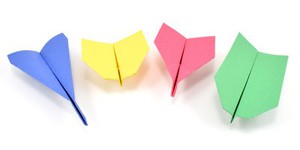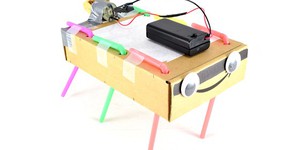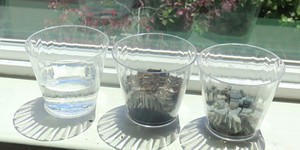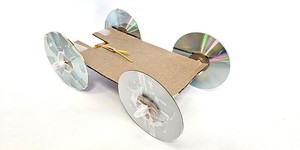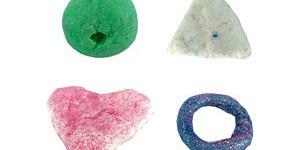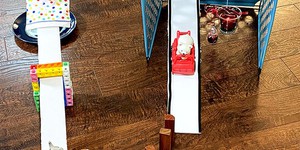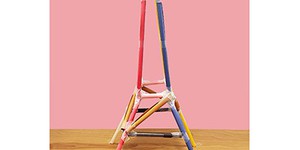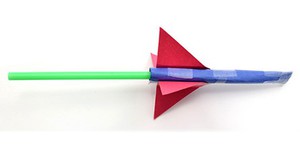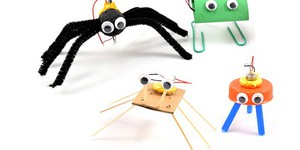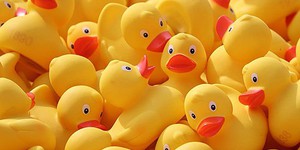Lesson Plans (247 results)
|
Select a resource
Sort by
|
Lesson Plan
Grade: 3rd-5th
18 reviews
Are paper airplanes a nuisance in your classroom? They don't have to be! Those distractions can be a constructive learning opportunity: use them to teach your students about the engineering design process. In this fun lesson, you will be the "customer" ordering a paper airplane, and your student teams will be engineering companies that will manufacture planes. Before they start making planes, they need to define the criteria and constraints of this engineering problem.
Read more
NGSS Performance Expectations:
Featured
Lesson Plan
Grade: 6th-8th
7 reviews
Junkbots are easy-to-build robots that you can make using a simple circuit and some recyclable materials. In this lesson, your students will learn about engineering design as they compete to build the fastest robot. No previous robotics experience is required!
Read more
NGSS Performance Expectations:
Lesson Plan
Grade: 4th-8th
3 reviews
The problems with using fossil fuels starts with extraction. In this activity, students "mine" chocolate chips out of cookies to demonstrate the effects mining can have on habitats.
Read more
NGSS Performance Expectations:
Lesson Plan
Grade: Kindergarten
3 reviews
Kindergarten students associate the sun with light and warmth. This lesson helps them expand this knowledge by getting their hands dirty! They will fill cups with soil, water and rocks and place them in the sun and shade for a while. By finding out how they can tell where a cup has been stored, they will learn how the sun affects Earth's surface.
In a follow-up lesson, Create Shade to Protect from the Sun, students figure out how to protect a territory from getting too hot in the sun.
Read more
NGSS Performance Expectations:
Lesson Plan
Grade: 3rd-5th
10 reviews
In this fun engineering lesson plan, your students will build rubber band-powered cars using readily available craft supplies. The challenge is to build a car that goes as far as possible while making careful use of materials.
Middle school and
high school
versions of this lesson plan are also available. You can enter your students' designs in the 2024 Science Buddies Engineering Challenge for a chance to win a cash prize for your school.
Note for K-2 teachers: you can do this…
Read more
NGSS Performance Expectations:
Lesson Plan
Grade: 6th-8th
27 reviews
Teach your students how to make plastic out of milk in this hands-on lesson plan! You will conduct a simple milk-transforming experiment to explore how plastics can be derived from a natural resource such as milk. Students will perform their own experiments and can even create a product from their resulting organic casein polymer.
Read more
NGSS Performance Expectations:
Lesson Plan
Grade: 6th-8th
2 reviews
Rube Goldberg machines—machines that complete a simple task in a convoluted way—are intriguing, artistic, and fun! In this lesson, students will design and build such a machine themselves and use the concept of kinetic energy in the process. Before students start designing, they will do an experiment that explores how kinetic energy depends on the mass and the speed of the moving object. With a clear understanding of this concept, students then tackle the engineering design…
Read more
NGSS Performance Expectations:
Lesson Plan
Grade: 6th-8th
2 reviews
Teach your students about the engineering design process with this fun lesson plan. They will design and build the tallest possible tower using nothing but paper and tape, but there's an additional twist on this classic activity. The tower must support a heavy weight at the top without collapsing! Teachers, note that elementary and high school versions of this lesson plan are also available.
The 2021 Engineering Challenge is over, but you can still try out this fun challenge with your…
Read more
NGSS Performance Expectations:
Lesson Plan
Grade: 3rd-5th
17 reviews
This lesson will introduce your students to the scientific method using a fun, hands-on activity.
A middle school version of this lesson plan is also available.
Read more
NGSS Performance Expectations:
Lesson Plan
Grade: 3rd-5th
3 reviews
Vibrobots are tiny robots powered by a vibrating motor, like the type found in cell phones. In this lesson plan, your students will learn about engineering design as they build their own vibrobots from craft materials. No previous experience with robots is required!
Read more
NGSS Performance Expectations:
Video Lesson
Grade: 6th-8th
8 reviews
Chemical reactions can result in interesting products! In this lesson, students learn how plastics are made by conducting a polymerization reaction in a simple milk-to-plastic transforming experiment. During their experiments, students will be able to compare the physical properties of their reactants (milk and vinegar) and their resulting organic casein polymer.
Read more
NGSS Performance Expectations:
|
Explore Our Science Videos
A Candle Seesaw – STEM activity
How To Curl Metals With Heat
Light-Tracking Bristlebot Instructions | Science Project

